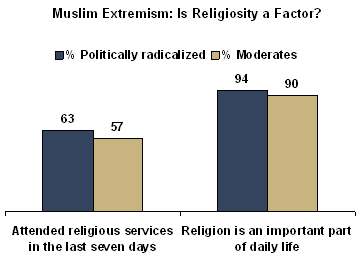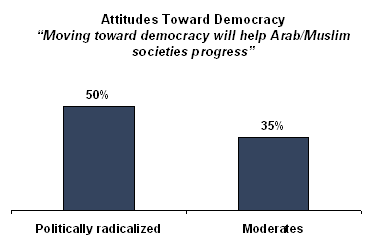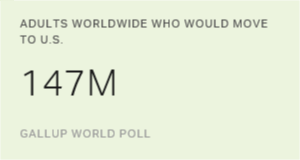GALLUP NEWS SERVICE
WASHINGTON, D.C. -- As the world witnesses the sixth anniversary of the Sept. 11 terrorist attacks and the U.S.-led "war on terror" begins its seventh year, hard questions must be asked about the core assumptions that are guiding policy in this battle. Are they leading to actions that help eliminate or inadvertently increase extremism?
Often U.S. policy-makers and other intellectuals draw an analogy between the Cold War and the current "global war on terror" and recommend analogous strategies, because, after all, both conflicts battled over people's hearts and minds. But results from Gallup's surveys in the Muslim world point to important differences between the two conflicts and real risks in confusing them by applying similar strategies.
At the heart of the Cold War analogy is the belief that religious fanaticism fuels extremism and therefore replacing Muslims' worldview with Western liberalism is the path to victory against terrorism. To begin to understand the danger of this diagnosis, we must first understand the factors that do and do not drive sympathy for violence.
As a starting point, Muslims do not hold a monopoly on extremist views. While 6% of Americans think attacks in which civilians are targets are "completely justified," in both Lebanon and Iran, this figure is 2%, and in Saudi Arabia, it's 4%. In Europe, Muslims in Paris and London were no more likely than were their counterparts in the general public to believe attacks on civilians are ever justified and at least as likely to reject violence, even for a "noble cause."
After analyzing survey data representing more than 90% of the global Muslim population, Gallup found that despite widespread anti-American sentiment, only a small minority saw the 9/11 attacks as morally justified. Even more significant, there was no correlation between level of religiosity and extremism among respondents. Among the 7% of the population that fits in the politically radicalized category -- those who saw the 9/11 attacks as completely justifiable and have an unfavorable view of the United States -- 94% said religion is an important part of their daily lives, compared with 90% among those in the moderate majority. And no significant difference exists between radicals and moderates in mosque attendance.

Gallup probed respondents further and actually asked both those who condoned and condemned extremist acts why they said what they did. The responses fly in the face of conventional wisdom. For example, in Indonesia, the largest Muslim majority country in the world, many of those who condemned terrorism cited humanitarian or religious justifications to support their response. For example, one woman said, "Killing one life is as sinful as killing the whole world ," paraphrasing verse 5:32 in the Quran.
On the other hand, not a single respondent in Indonesia who condoned the attacks of 9/11 cited the Quran for justification. Instead, this group's responses were markedly secular and worldly. For example, one Indonesian respondent said, "The U.S. government is too controlling toward other countries, seems like colonizing."
The real difference between those who condone terrorist acts and all others is about politics, not piety. For example, the politically radicalized often cite "occupation and U.S. domination" as their greatest fear for their country and only a small minority of them agree the United States would allow people in the region to fashion their own political future or that it is serious about supporting democracy in the region. Also, among this group's top responses was the view that to better relations with the Muslim world, the West should respect Islam and stop imposing its beliefs and policies. In contrast, moderates most often mentioned economic problems as their greatest fear for their country, and along with respecting Islam, they see economic support and investments as a way for the West to better relations. Moderates are also more likely than the politically radicalized to say the United States is serious about promoting democracy.
While the politically radicalized are as likely as the moderate majority to say better relations with the West is of personal concern to them, they are much less likely to believe the West reciprocates this concern and therefore much less likely to believe improved relations will ever come. In short, perceptions of being under siege characterize those who sympathize with extremism.
The Cold War analogy of the war on terror also assumes that Muslim grievances are rooted in a rejection of modernity and Western values, not specific policies. Statistical evidence indicates otherwise.
For instance, while the United States and Great Britain are generally viewed unfavorably, respondents' opinions of France and Germany are relatively positive, even when compared with respondents' opinions of other Muslim nations, suggesting negative sentiment is drawn along political, not cultural or religious lines.
Moreover, despite intense political anger at some Western powers, Muslims do not reject Western values wholesale. Citizens of countries from Saudi Arabia to Morocco, from Indonesia to Pakistan, express admiration for Western technology and democratic values such as freedom of the press and government accountability. The politically radicalized are actually more likely than the moderate majority to say greater democracy will help Muslims progress.

Defining the current conflict as a battle between Western values and "radical Islam" misses the root cause of terrorism while energizing the very perception that fuel sympathy for it -- that Islam itself is under attack. These findings begin to expose the danger of acting on the Cold War-war on terror analogy. In basic terms, the Cold War was about convincing people that communism was bad and that American democracy was good. The current war is about not appearing to denigrate Islam or impose a secular democracy that excludes faith, because it is this perception that fuels extremist sentiment and alienates those mainstream Muslims who want a democracy compatible with religious values.
The Cold War involved bringing down repressive communist governments in places such as Eastern Europe, where the ruling elites were largely unpopular with the people. The current war involves, at times, propping up unpopular repressive governments as a safeguard against the terrorists. Ironically, this support fuels more animosity against the United States and thus empowers the violent extremists. Most importantly, many have claimed that "blue jeans and Playboy" brought down the Soviet Union as much as strong military deterrence. In sharp contrast, it is precisely America's military power and popular culture, and their perceived threat to Muslims, that extremists exploit to gain support. In short, much of what worked in the Cold War will have the opposite effect now.
From many Muslims' point of view, the conflict with West is about policy, not principles. Through Muslim eyes, it looks like a global civil rights struggle much more than another clash between superpowers. When the conflict is viewed through this lens, seemingly inexplicable crises such as the Muslim reaction to the Danish cartoons, come into sharper focus, as does a more effective strategy forward.
Thoughtful observers have drawn a comparison between the Danish cartoon controversy and an incident from America's own cultural relations struggle: the 1965 Watts riots. Looking at the cartoon controversy through the analogous lens of race relations reveals some insights. In both cases, violent riots broke out in reaction to what seemed to outsiders as a "petty offense." In the case of the Watts riot, white police officers in a predominantly black neighborhood pulled over two black males whom they believed were driving while intoxicated. In the case of the cartoons, a Danish newspaper, followed by other European newspapers, printed a cartoon depicting Islam's most venerated figure, the Prophet Muhammad, as a terrorist.
As a result of the Watts riots, 34 people were officially reported killed, more than 1,000 people were injured, and an estimated $35 million in damage was caused (more than $150 million in today's currency). The Kerner Commission, set up by President Lyndon B. Johnson in 1967 to study the spate of race riots, pointed to the distinction between the "trigger" (a petty act) and the "cause" -- a long list of problems identified by the commission. These included poverty, job and housing discrimination, and unequal education, as well as a deep sense of racism and disrespect on the part of a powerful and affluent white America toward a powerless and poor black America, personified by the white police officers' treatment of the black men.
Like those who rioted in Watts, and in other American cities during the country's civil rights struggle, Muslim rioters were not angry because they did not understand the value of free speech in principle -- many cite this liberty as among the most admired aspects of the West. Instead, the Danish cartoons were simply the "trigger" igniting the combustible fuel of widespread perceptions of Western injustice and disrespect.
Several developments followed the Kerner Commission's report and the violence that initiated it: Greater attention was paid to the grievances the commission identified, which were not rendered void simply because people chose a violent way to protest them. Significantly, change occurred in two major areas. The first was policy: Laws were passed and some changed to address these issues, such as the Civil Rights Act of 1968 prohibiting discrimination concerning the sale, rental, and financing of housing. The second was a greater cultural sensitivity: It slowly became less socially acceptable to use racist images of blacks in media. For example, in 1966, CBS withdrew reruns of the Amos 'n' Andy show, which the National Association for the Advancement of Colored People (NAACP) had been protesting since the 1950s.
Was the NAACP protesting racist depictions of blacks because they didn't value free speech? Were rioters angry because they didn't understand the value of traffic laws? And were the corresponding changes on the part of U.S. media and government "concessions" to violence and intimidation by special interests groups or signs of a weakened American democracy and free speech? Some might argue yes, but others would simply see this as a natural progression of an increasingly inclusive American democracy, and that it is a better place today because it did.
While an extremist fringe, such as the Black Panther Party, called for violent means of change, the effectiveness of movements and organizations to address widely held grievances peacefully marginalized their appeal. Lessons learned from America's civil rights struggle help clarify how to begin to bridge the divide globally between the United States and the Muslim world. Thus, a two-pronged approach of outreach to the moderate majority through job creation, along with support for those who wish to address widely held grievances peacefully, will diminish the appeal of those who advocate violence.
Dalia E. Mogahed is Executive Director of The Center for Muslim Studies at The Gallup Organization and co-author with John L. Esposito of forthcoming Who Speaks for Islam?: What a Billion Muslims Really Think.
These results are based on in-home, in-person interviews with randomly selected national samples (urban and rural) of approximately 1,000 adults, aged 15 years and older, conducted in countries with predominantly Muslim or substantially Muslim populations from 2005 through 2007. These surveys were conducted as part of the Gallup World Poll. For results based on samples of this size, one can say with 95% confidence that the maximum error attributable to sampling and other random effects is ±3 percentage points. In addition to sampling error, question wording and practical difficulties in conducting surveys can introduce error or bias into the findings of public opinion polls.
This is a revised version of an article that was originally published in issue 20, 2007 of ISLAMICA Magazine.
